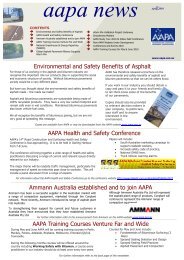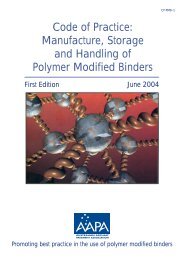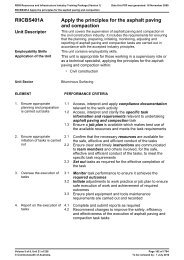Asphalt Review - Volume 29 Number 2 (June / July 2010)
Asphalt Review - Volume 29 Number 2 (June / July 2010)
Asphalt Review - Volume 29 Number 2 (June / July 2010)
Create successful ePaper yourself
Turn your PDF publications into a flip-book with our unique Google optimized e-Paper software.
Even if limited deformation of the subsoil<br />
does take place, this will not affect<br />
the asphalt layer because it is capable of<br />
withstanding the deformation without<br />
loosing its integrity because of the viscoelastic<br />
properties of asphalt.<br />
- Noise and vibrations<br />
The mechanical properties of the asphalt<br />
layer will lead to a reduction in the<br />
vibrations and noise produced by passing<br />
trains. The use of modified asphalt<br />
(polymer modified bitumen, rubber<br />
crumb) can further improve the vibration<br />
dampening effect of the sub-ballast.<br />
- The ballast-less track / the direct<br />
application of the sleepers on the<br />
asphalt<br />
For many years there have been<br />
developments aimed at improving the<br />
stability of the traditional rail-track<br />
structure of rail, sleepers and ballast. The<br />
introduction of high-speed trains and<br />
the desire for less maintenance led to the<br />
development of the ballast-less track. In<br />
this form of construction the ballast is<br />
replaced by a rigid monolithic element<br />
that directly supports the sleepers. This<br />
can be achieved by placing the track frame<br />
of rail and sleepers directly on an asphalt<br />
construction.<br />
The most important requirement is<br />
to have a perfectly flat and level asphalt<br />
surface to comply with the narrow<br />
tolerances that are required for rail<br />
level (+/- 2 mm). Modern asphalt laying<br />
machines can fulfil this requirement using<br />
modern levelling equipment.<br />
The advantages of these systems are the<br />
elasticity of the asphalt layer, especially<br />
when polymer modified asphalt is<br />
used, and the ease of construction and<br />
maintenance. Another important factor<br />
in favour of this system is the ability<br />
to carry out minor corrections without<br />
demolishing and reconstructing the base.<br />
Because these systems eliminate the use<br />
of ballast they have the great advantage<br />
of lowering the track base, allowing the<br />
construction of tunnels with smaller<br />
diameter. The first successful application<br />
of the ballast-less tracks dates back to the<br />
beginning of the 1990s, in Germany. Other<br />
experimental tracks have been built since<br />
then, mostly in Germany.<br />
Experiences in Italy and Germany<br />
Italy<br />
The first experience with asphalt mixes<br />
in high-speed railway construction in<br />
Italy date from the early 1970s. Since<br />
then hundreds of kilometres have been<br />
RAIL.ONE. All rights reserved<br />
built and the results have been very<br />
satisfactory with the application of an<br />
asphalt sub-ballast layer contributing<br />
to the stability of the rail geometry.<br />
In particular, at critical points such as<br />
switch points, expansion joints, level<br />
crossings and in areas between concrete<br />
structures (bridges) and embankments,<br />
where dynamic forces are substantial,<br />
the asphalt sub-ballast layer introduced<br />
a remarkable improvement of the<br />
superstructure stability.<br />
The sub-ballast is made up of an<br />
asphalt mix (100-140 mm thickness)<br />
laid by normal paving machines. It has<br />
the typical behaviour and well-known<br />
advantages of visco-elastic materials.<br />
When the asphalt mix solution is<br />
compared with cement mix solutions<br />
for the sub-ballast, the following<br />
advantages are evident in favour of<br />
asphalt:<br />
• reduced use of aggregates due to<br />
the lesser thickness of the asphalt<br />
sub-ballast layer (average 120 mm<br />
thickness compared to at least 200<br />
mm);<br />
• cracks are less likely to emerge;<br />
• there is no need to protect the<br />
finished surface by means of<br />
bitumen membranes or emulsion<br />
spray;<br />
• time for “hardening” is much<br />
shorter.<br />
Experience shows that the presence<br />
of an asphalt sub-ballast layer in<br />
the railway structure also results in<br />
a reduction in noise and vibrations<br />
transmitted to the surrounding<br />
environment and to passengers.<br />
Germany - Solid Railway Trackbed<br />
General Issues<br />
The rail web (rails and sleepers) with<br />
ballast bedding type of construction has<br />
reached a level that is hardly capable of<br />
improvement as a classical construction<br />
method for railway track. Furthermore,<br />
in the case of routes designed for very<br />
rapid passenger traffic, it has been<br />
found that wear and tear takes place<br />
much more quickly than expected<br />
through stone displacement, breakage<br />
and abrasion because of the dynamic<br />
traffic loads on the railway ballast.<br />
As a result, track bed deterioration<br />
occurs more frequently and requires<br />
maintenance work at more frequent<br />
intervals. This maintenance work is<br />
costly and disrupts normal railway<br />
operations.<br />
ROADS JUNE <strong>2010</strong>/JULY <strong>2010</strong> 41

















